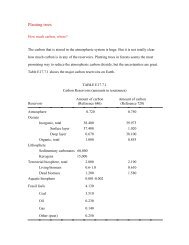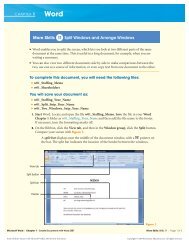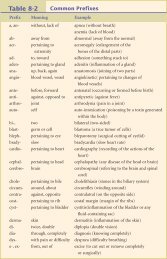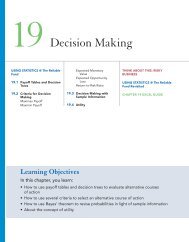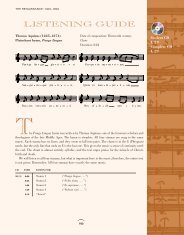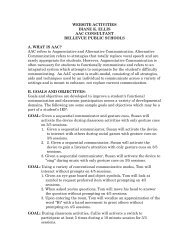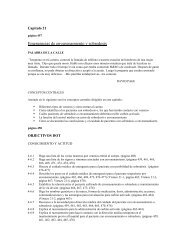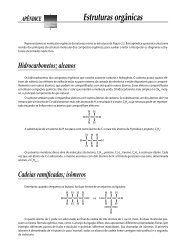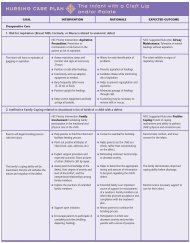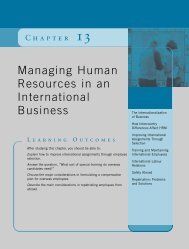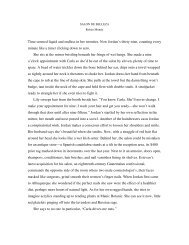chapter
chapter
chapter
You also want an ePaper? Increase the reach of your titles
YUMPU automatically turns print PDFs into web optimized ePapers that Google loves.
214 Unit Three Forces Within<br />
Figure 7.18 Schematic illustration of<br />
paleomagnetism preserved in lava flows of<br />
various ages. Data such as these from<br />
various locales were used to establish the<br />
time scale of polarity reversals shown in<br />
Figure 7.19.<br />
1.2 m.y. ago<br />
(normal)<br />
Age<br />
Present<br />
0.8 m.y. ago<br />
(reversed)<br />
conclude that a faster spreading rate exists for the spreading<br />
center of the Pacific as compared to the Atlantic.<br />
When we apply absolute dates to these magnetic events,<br />
we find that the spreading rate for the North Atlantic<br />
Ridge is only 2 centimeters per year. The rate is somewhat<br />
faster for the South Atlantic. The spreading rates<br />
Jaramillo<br />
normal<br />
event<br />
Olduvai<br />
normal<br />
event<br />
Mammoth<br />
reversed<br />
event<br />
Brunhes<br />
normal<br />
Matuyama<br />
reversed<br />
Gauss<br />
normal<br />
Gilbert<br />
reversed<br />
1<br />
2<br />
3<br />
4<br />
(millions of<br />
years ago)<br />
Figure 7.19 Time scale of Earth’s magnetic field in the recent<br />
past. This time scale was developed by establishing the magnetic<br />
polarity for lava flows of known age. (Data from Allen Cox and<br />
G. B. Dalrymple)<br />
0.4 m.y. ago<br />
(normal)<br />
Normal<br />
magnetic<br />
field<br />
for the East Pacific Rise generally range between 6 and 12<br />
centimeters per year, with a maximum rate exceeding 15<br />
centimeters (6 inches) per year in one segment. Thus, we<br />
have a magnetic tape recorder that records changes in<br />
Earth’s magnetic field. This recorder also permits us to<br />
determine the rate of seafloor spreading.<br />
Evidence: Earthquake Patterns<br />
By 1968, the basic outline of global tectonics was firmly<br />
established. In that same year, three seismologists<br />
published papers demonstrating how successfully the<br />
new plate tectonics model accounted for the global distribution<br />
of earthquakes (Figure 7.21). In particular,<br />
these scientists were able to account for the close association<br />
between deep-focus earthquakes and ocean<br />
trenches. Furthermore, the absence of deep-focus earthquakes<br />
along the oceanic ridge system was also shown<br />
to be consistent with the new theory.<br />
The close association between plate boundaries and<br />
earthquakes can be seen by comparing the distribution<br />
of earthquakes shown in Figure 7.21 with the map of<br />
plate boundaries in Figure 7.8 and trenches in Figure<br />
7.13. In trench regions where dense slabs of lithosphere<br />
plunge into the mantle, this association is<br />
especially striking. When the depths of earthquake foci<br />
and their locations within the trench systems are plotted,<br />
an interesting pattern emerges. Figure 7.22, which<br />
shows the distribution of earthquakes in the vicinity of<br />
the Japan trench, is an example. Here most shallowfocus<br />
earthquakes occur within, or adjacent to, the<br />
trench, whereas intermediate- and deep-focus earthquakes<br />
occur toward the mainland.<br />
In the plate tectonics model, deep-ocean trenches<br />
are produced where cool, dense slabs of oceanic litho-




